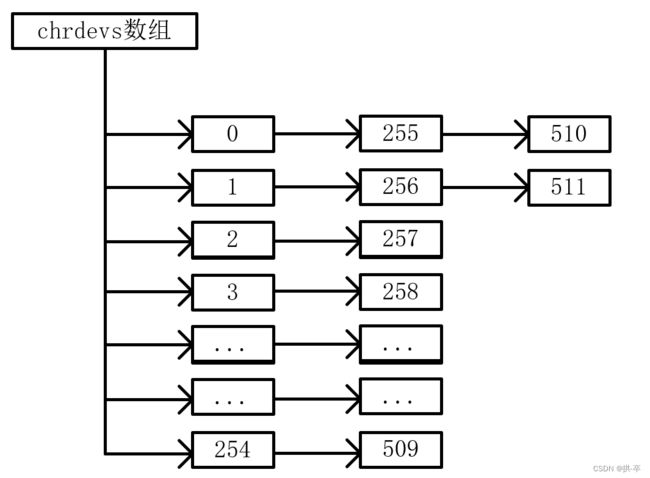【linux API 分析】register_chrdev
linux kernel:4.19
在注册字符设备的时候,可使用register_chrdev()函数,其对应的注销函数是unregister_chrdev(),其定义是在include\linux\fs.h文件
register_chrdev()
首先分析register_chrdev()函数
其定义如下
static inline int register_chrdev(unsigned int major, const char *name,
const struct file_operations *fops)
{
return __register_chrdev(major, 0, 256, name, fops);
}
该函数会调用__register_chrdev()函数,其定义位于fs\char_dev.c文件
/**
* __register_chrdev() - create and register a cdev occupying a range of minors
* @major: major device number or 0 for dynamic allocation
* @baseminor: first of the requested range of minor numbers
* @count: the number of minor numbers required
* @name: name of this range of devices
* @fops: file operations associated with this devices
*
* If @major == 0 this functions will dynamically allocate a major and return
* its number.
*
* If @major > 0 this function will attempt to reserve a device with the given
* major number and will return zero on success.
*
* Returns a -ve errno on failure.
*
* The name of this device has nothing to do with the name of the device in
* /dev. It only helps to keep track of the different owners of devices. If
* your module name has only one type of devices it's ok to use e.g. the name
* of the module here.
*/
int __register_chrdev(unsigned int major, unsigned int baseminor,
unsigned int count, const char *name,
const struct file_operations *fops)
{
struct char_device_struct *cd;
struct cdev *cdev;
int err = -ENOMEM;
cd = __register_chrdev_region(major, baseminor, count, name);
if (IS_ERR(cd))
return PTR_ERR(cd);
cdev = cdev_alloc();
if (!cdev)
goto out2;
cdev->owner = fops->owner;
cdev->ops = fops;
kobject_set_name(&cdev->kobj, "%s", name);
err = cdev_add(cdev, MKDEV(cd->major, baseminor), count);
if (err)
goto out;
cd->cdev = cdev;
return major ? 0 : cd->major;
out:
kobject_put(&cdev->kobj);
out2:
kfree(__unregister_chrdev_region(cd->major, baseminor, count));
return err;
}
__register_chrdev()函数首先调用__register_chrdev_region()函数
/*
* Register a single major with a specified minor range.
*
* If major == 0 this functions will dynamically allocate a major and return
* its number.
*
* If major > 0 this function will attempt to reserve the passed range of
* minors and will return zero on success.
*
* Returns a -ve errno on failure.
*/
static struct char_device_struct *
__register_chrdev_region(unsigned int major, unsigned int baseminor,
int minorct, const char *name)
{
struct char_device_struct *cd, **cp;
int ret = 0;
int i;
cd = kzalloc(sizeof(struct char_device_struct), GFP_KERNEL);
if (cd == NULL)
return ERR_PTR(-ENOMEM);
mutex_lock(&chrdevs_lock);
if (major == 0) {
ret = find_dynamic_major();
if (ret < 0) {
pr_err("CHRDEV \"%s\" dynamic allocation region is full\n",
name);
goto out;
}
major = ret;
}
if (major >= CHRDEV_MAJOR_MAX) {
pr_err("CHRDEV \"%s\" major requested (%u) is greater than the maximum (%u)\n",
name, major, CHRDEV_MAJOR_MAX-1);
ret = -EINVAL;
goto out;
}
cd->major = major;
cd->baseminor = baseminor;
cd->minorct = minorct;
strlcpy(cd->name, name, sizeof(cd->name));
i = major_to_index(major);
for (cp = &chrdevs[i]; *cp; cp = &(*cp)->next)
if ((*cp)->major > major ||
((*cp)->major == major &&
(((*cp)->baseminor >= baseminor) ||
((*cp)->baseminor + (*cp)->minorct > baseminor))))
break;
/* Check for overlapping minor ranges. */
if (*cp && (*cp)->major == major) {
int old_min = (*cp)->baseminor;
int old_max = (*cp)->baseminor + (*cp)->minorct - 1;
int new_min = baseminor;
int new_max = baseminor + minorct - 1;
/* New driver overlaps from the left. */
if (new_max >= old_min && new_max <= old_max) {
ret = -EBUSY;
goto out;
}
/* New driver overlaps from the right. */
if (new_min <= old_max && new_min >= old_min) {
ret = -EBUSY;
goto out;
}
if (new_min < old_min && new_max > old_max) {
ret = -EBUSY;
goto out;
}
}
cd->next = *cp;
*cp = cd;
mutex_unlock(&chrdevs_lock);
return cd;
out:
mutex_unlock(&chrdevs_lock);
kfree(cd);
return ERR_PTR(ret);
}
其次调用cdev_alloc()函数
struct cdev *cdev_alloc(void)
{
struct cdev *p = kzalloc(sizeof(struct cdev), GFP_KERNEL);
if (p) {
INIT_LIST_HEAD(&p->list);
kobject_init(&p->kobj, &ktype_cdev_dynamic);
}
return p;
}
然后调用cdev_add()函数
/**
* cdev_add() - add a char device to the system
* @p: the cdev structure for the device
* @dev: the first device number for which this device is responsible
* @count: the number of consecutive minor numbers corresponding to this
* device
*
* cdev_add() adds the device represented by @p to the system, making it
* live immediately. A negative error code is returned on failure.
*/
int cdev_add(struct cdev *p, dev_t dev, unsigned count)
{
int error;
p->dev = dev;
p->count = count;
error = kobj_map(cdev_map, dev, count, NULL,
exact_match, exact_lock, p);
if (error)
return error;
kobject_get(p->kobj.parent);
return 0;
}
综上register_chrdev函数调用流程如下
register_chrdev()
-->__register_chrdev()
-->__register_chrdev_region()
-->cdev_alloc()
-->cdev_add()
从__register_chrdev_region()函数可以看出,该函数会根据传入的参数,去完善结构体 char_device_struct(除cdev结构体),并返回该结构体地址
static struct char_device_struct {
struct char_device_struct *next;
unsigned int major;
unsigned int baseminor;
int minorct;
char name[64];
struct cdev *cdev; /* will die */
} *chrdevs[CHRDEV_MAJOR_HASH_SIZE];
该结构体中,存在一个链表,链表的作用分析如下:
#define CHRDEV_MAJOR_HASH_SIZE 255
可以看出分配的结构体指针数组有255个元素,由于有的主设备号大于254,故需要除以255取余,这样,当主设备号为256时,除以255取余为1,故存在数组chrdev[1]中,但chrdev也可存主设备号为1的元素,故使用链表,使主设备号为1的char_device_struct的next成员指向主设备号为256的char_device_struct
对于cdev结构体,其内容如下
struct cdev {
struct kobject kobj;
struct module *owner;
const struct file_operations *ops;
struct list_head list;
dev_t dev;
unsigned int count;
} __randomize_layout;
cdev_alloc()函数,该函数为cdev结构体分配内存空间,并初始化list以及kobj成员
对于kobj目前我没搞清楚,在这个时候看到了一篇文章,写得不错,有兴趣的去看这篇文章吧
链接: link
